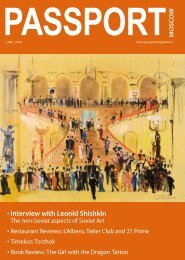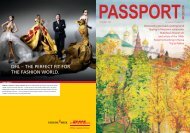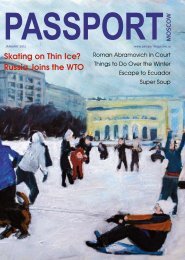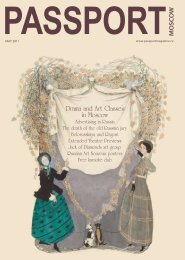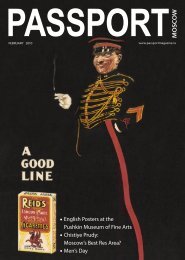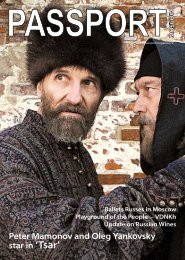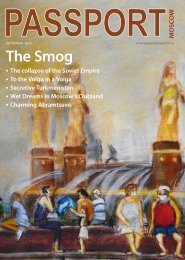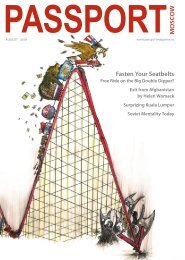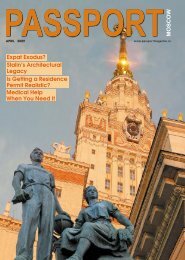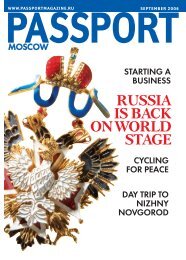You also want an ePaper? Increase the reach of your titles
YUMPU automatically turns print PDFs into web optimized ePapers that Google loves.
25th and another on the 7th of January) and two New Years; (the<br />
1st of January and the old New year on the 14th). Russian New Year<br />
is reminiscent of a European Christmas. Or is it? Appearances can<br />
be deceptive. The Russians are not actually celebrating Christmas<br />
at all, but New Year in a slightly Christmassy way.<br />
When you look more closely, illusions are broken. Everything<br />
appears awkwardly upside down. Firstly, you discover<br />
New Year is celebrated before Christmas and afterwards New<br />
Year again. Then don’t forget that some people still pay homage<br />
to old pre-Christian pagan customs, (Svyatki, a time of<br />
revelry and fortune telling from January 7th to 19th). You may<br />
ask, “How can you celebrate the old New Year?” Isn’t it an<br />
oxymoron? We need a brief historical explanation.<br />
HISTORY<br />
The date of New Year has constantly changed over the centuries.<br />
This is because it was originally celebrated as part of<br />
the winter solstice which marked the shortest time of year.<br />
This represented a major turning point, when the life-giving<br />
sun returned. The problem is that the precession of equinoxes<br />
changes over the centuries. So although the solstice has<br />
moved from the date of the 6th of January to the 25th of December,<br />
many religions preserve the old dates. If we followed<br />
the solstice with fidelity we would currently celebrate Christmas<br />
on the 22nd of December!<br />
Up until the 14th century, New Year was originally celebrated<br />
from the first of March, then later from the first of September<br />
and finally, in 1700, along with imported Yolki from northern<br />
Europe, on the first of January.<br />
Before Peter the Great, the peasants celebrated New Year<br />
not only according to the winter solstice but according to<br />
their locality in Russia. It was celebrated unsystematically. So<br />
there was a lot of confusion as to how to celebrate. Peter the<br />
Great sought to impose order. He issued the following edict:<br />
“Due to the New Year being celebrated so differently<br />
around the country, a date has been chosen to end this idiotic<br />
confusion: the first of January. As a sign of a good start<br />
to the year; people must cheerfully greet each other on New<br />
Year’s Day and wish each other good fortune and in families,<br />
wish each other prosperity. In honour of the New Year, people<br />
must make decorations from fir trees, entertain children and<br />
sledge down hills. Adults should refrain from fist-fighting and<br />
getting drunk-there are enough days for this already.”<br />
Yet even after this order, New Year, wasn’t a truly national holiday.<br />
It largely remained the prerogative of the rich. Most of the<br />
poor couldn’t or wouldn’t celebrate it until the 19th century.<br />
After the Revolution, the celebration was banned as “bourgeois<br />
nonsense” and only revived in the mid-1930s. Ded Moroz<br />
(Father Frost) was outlawed until being “rehabilitated” in<br />
the 1930s. The Bolsheviks switched from the Julian calendar<br />
to the Gregorian, which had been used in most of western<br />
Europe since the seventeenth century, thereby transferring<br />
the celebration of Christmas to the 25th of December from<br />
the 7th of January—except that most real Russian Orthodox<br />
Christians paid little attention to what the atheist Bolsheviks<br />
wanted.<br />
PAGANISM<br />
Paganism remains remarkably resilient in this country. Russian<br />
peasants called upon many deities to save them from the<br />
long remorseless winter, and well they might. For instance,<br />
a peasant might worship the goddess Poludnitza for a fa-<br />
January 2011<br />
The Way It Is<br />
vorable harvest, or Lada (not just a car), to assure a safe journey<br />
through a largely roadless country and the god Vlas to<br />
protect his cattle. The sun god Dazhbog was highly popular.<br />
From Dazhbog we derive the Russian phrase, “Dai vam Bog<br />
zdoroviya”, which means, “God give you good health.”<br />
The Russian peasant poetically viewed the sun as a father<br />
who was married to a female moon. All the stars were their<br />
children. In the spring, the sun courted the moon but in<br />
winter the sun vanished. This left the peasants vulnerable<br />
to an evil deity called Morozh. This evil deity threatened to<br />
freeze to death any peasant who offended him, so peasants<br />
celebrated the New Year by leaving apples under a tree to<br />
appease his anger! The origins of Ded Moroz lie with a more<br />
literal translation as evil “grandfather frost” who represented<br />
winter. Only later, as a literary reinvention, was he transformed<br />
into a benevolent figure with his charming granddaughter<br />
Snegurochka.<br />
Peasants would also hang animal shaped biscuits on a tree<br />
to honour the harvest Goddess.<br />
From the 7-19th of January during “Svyatki,” the peasants<br />
might indulge in fortune telling; gadaniya, and parading<br />
through the streets in animal costumes, which all sounds like<br />
a lot of fun. Bonfires were lit to woo back the life-giving sun<br />
and to warm the dead!<br />
How is New Year celebrated now? It is still largely a warm,<br />
cosy and vibrant family occasion where people gather at<br />
home around a table of caviar sandwiches, olives, potato and<br />
fish salads, and of course bottles of Soviet champagne and<br />
vodka. Many of the pickled vegetables you enjoy are grown<br />
by families at their dachas. Fortune telling and partying are<br />
not unheard of. There aren’t so many animal impersonation<br />
sessions these days, publicly at least, but nevertheless the pagan<br />
side is there.<br />
Yet the influence of western trends can be discerned.<br />
Nowadays, the festival is being celebrated beyond the family<br />
hearth. More and more Russians are celebrating it in Prague<br />
or London, for example. How you celebrate it largely depends<br />
on your character and current bank account.<br />
RUSSIAN CHRISTMAS<br />
When you watch an Orthodox Church service it seems sombre.<br />
This may betray the imperceptible influence of paganism.<br />
There is a notion that in order to distinguish themselves<br />
from a pagan “laughter cult”, the Orthodox decided to forbid<br />
laughing.<br />
From November 28th until the 6th of January, Russian Orthodox<br />
Christians fast for 39 days! On the night of Christmas<br />
(the 7th of January) they mark the event by walking around<br />
the church holding lit candles (called a Krestniy Khod). This<br />
event itself recalls how pagans would walk clockwise in the<br />
direction of the sun to summon its energy. The choirs sing<br />
movingly, the incense smells sweet and the chanting of the<br />
liturgy is other-worldly. Here you are entering a world unaltered<br />
for centuries.<br />
Incidentally, the red star you see on some New year Yolki is<br />
an emblem of Christmas. It symbolises the emergence of the<br />
morning star which guided the three Kings to the new born<br />
Christ. Boris Pasternak in his poem Christmas Star, describes<br />
the star as a flash of arson soaring through the sky. It is the<br />
spiritual beauty of this fire, whether in bonfires, the eternal<br />
flame or candles which best sums up how the Russians love to<br />
greet Christmas. P<br />
25



